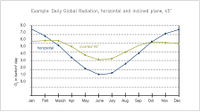Knowledge fuels change
For over a decade, Energypedia has shared free, reliable energy expertise with the world.
We’re now facing a serious funding gap.
Help keep this platform alive — your donation, big or small, truly matters!
Thank you for your support
SPIS Toolbox - Specifics of Solar Energy

Introduction
Do want to know all about SPIS – Solar Powered Irrigation System : Please go to the newly launched standalone Solar Powered Irrigation Systems (SPIS) website (www.spis-toolbox.org) , featuring three SPIS toolbox:
- Toolbox for beginners,
- Toolbox for farmers (new SPIS Web based App – to calculate design of the pumps),
- the Toolbox for experts - the updated version - Version 6
and additional resources (Publication about SPIS).
The Toolbox on Solar Powered Irrigation Systems (SPIS) is designed to enable advisors, service providers and practitioners in the field of solar irrigation to provide broad hands-on guidance to end-users, policy-makers and financiers. Risks related to system efficiency, financial viability and the unsustainable use of water resources can thus be minimized. The Toolbox comprises informative modules supplemented with user-friendly software tools (calculations sheets, checklists, guidelines). read more
Modules and tools touch upon:
- assessing the water requirements,
- comparing the financial viability,
- determining farm profitability and payback of investment in SPIS,
- sustainably design and maintain a SPIS,
- highlight critical workmanship quality aspects,
- and many more.

style="width: 160px; background-color: rgb(111, 142, 43);" | ►Back to the Module Page
Specifics of Solar Energy
Solar radiation
Solar energy has some specific characteristics that must be considered when planning a Solar-Powered Irrigation System. Solar radiation captured by a solar panel is never constant due to daily and seasonal variations of solar radiation. The intensity of solar radiation on a surface is called irradiance (S). The irradiance is measured in watts per square meter [W/m²].
Solar irradiance varies over the course of the day, with maximum values of about 1,000 W/m² on a horizontal surface at sea level around noon on a clear day. The energy carried by radiation on a surface over a certain period of time is called global solar radiation (G). The global solar radiation is location-specific as it is influenced by cloud, air humidity, climate, elevation and latitude, etc. The global solar radiation on a horizontal surface is measured by a network of meteorological stations all over the world and is expressed in kilowatt hours per square meter [kWh/m²].
Tilt angle
Most solar panels are installed with a fixed tilt angle “α” to increase the energy yield. Tilt angle is site-specific and has to be calculated. This can easily be done with the help of software tools such as the meteorological database METEONORM, which provides climate data for almost every location in the world. A quick estimate of the right tilt angle α can be established when looking at the latitude in which the pumping system is installed.
Typical values for the tilt angle can be estimated to:
α = absolute value of geographic latitude + / - 10º
To allow rain water and accumulated dust to run off the panel surface, the tilt angle should be at least 15°, even if the system is installed close to the equator. To focus the applications in winter months, the tilt angle might be increased up to +10º, for summer months, the tilt angle might be reduced up to -10º.
Orientation of the solar generator
In the northern hemisphere, the panels should be facing south to maximize the energy yield, whereas in the southern hemisphere, panels should be facing north. Deviations from true north/south are possible but will result in a reduced overall energy yield.
Another method to further increase the energy yield of a solar generator is solar tracking (see Chapter 2).





















